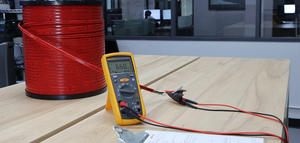How do hazardous industries eliminate explosions while boosting efficiencies?
Keeping staff, equipment, sites, and the environment safe from explosion or fire is front of mind for business leaders in industries with flammable materials or substances. Extreme caution is a must for those working in high-risk environments. Yet, at what point does caution begin to hold companies back regarding efficiency, progress, and innovation? In many cases, we have seen companies still using pen and paper instead of introducing mobile technologies for fear of handheld devices heating up or sparking and causing a fire or explosion. Manual processes such as pen and paper will eventually reduce any competitive advantage and future growth.
Sparks fly across sectors
The most common cause of workplace fires is electrical equipment. Electrical faults cause many nonresidential fires and can start suddenly and spread quickly. In March 2018, for example, an unexpected electrical fault caused a devastating blaze in a Brixham foundry, causing substantial damage to the building.
More recently, a UK chemicals factory was set alight due to a spark coming into contact with explosive liquids. The company had to pay thousands of pounds in legal fees and the cost of rebuilding its factory – and loss of revenue.
The distillery industry is another prime example where a tiny spark can cause a significant fire. A distillery fire near Birmingham caused more than 200 people to flee their homes as 70 firefighters battled the inferno. A 21-year-old distillery worker was rescued from the blaze, suffering 20% burns to his head, neck, and hands. The fire also destroyed the warehouse and its stocks and caused damage to nearby cars and houses. According to the HSE inspector who worked on the case: "Companies that fail to ensure the integrity of their safety-critical equipment place their employees, members of the public, emergency services, and their entire livelihood at risk of serious harm. Poor management of highly flammable liquids can have catastrophic results for individuals and businesses."
These are just a few examples of significant fires in hazardous environments, yet there are many more across industries and the world.

Intrinsically safe workplace devices
Companies still working with pen and paper in the workplace could introduce handheld devices for increased efficiency without the risk of sparks or heating up.
Here at BARTEC, we work with Zebra Technologies to transform their ultra-rugged mobile devices into certified ones that can safely operate in potentially explosive areas. These areas can be:
- Zone 1/Division 1: Where the risk of explosion is present under normal operating conditions
- Zone 2/Division 2: Where hazards are only present under abnormal operating conditions
We modify the Zebra Technologies handheld devices to speed up efficiency, provide accuracy and streamline workflows, freeing up time for staff and modernizing workplaces at risk of explosion. These devices eliminate the use of pen and paper and bring industries up-to-speed, providing competitive advantage and deep insights into how a business runs.
The modified devices are intrinsically safe (IS) or non-incendive (NI). The main difference between the two types of equipment is that NI circuits are evaluated for ignition capability under normal operating conditions, while IS circuits are tested under fault conditions.
- Intrinsically safe (IS): the device is incapable of ignition even in the event of up to two independent faults and can be used throughout all hazardous area classifications.
- Non-Incendive (NI): the device is incapable of ignition under normal operation conditions (no faults) and is restricted to use only in Zone 2/22 and Div 2 areas.
Case study: Food ingredients company
We recently worked with leading systems integrator VisionID and a food ingredients company to deliver handheld BARTEC devices for its factories. Now fully installed, they provide the following:
- A stable and safe platform for information-sharing and reporting.
- Stock visibility in real-time.
- Increased efficiency in potentially hazardous sites across Europe.
About us
We provide intrinsically safe handheld solutions across a wide range of sectors where explosions may occur, from the oil and gas industry to chemical, petrochemical, and pharmaceutical sectors, distilleries, mining, and airports – anywhere a potentially explosive area exists.
We also work with the strictest and most renowned notified bodies to modify ultra-rugged mobile devices into certified ones to meet stringent safety requirements, including ATEX, IECEx, and NEC, as well as other country-specific standards.
If you work in a potentially explosive environment and believe your teams could benefit from greater efficiency using handheld devices, browse our mobile devices' portfolio or contact us at shop@bartec.com to speak to an expert in hazardous area-safe solutions.
(1) www.delta-net.com/health-and-safety/fire-safety/f...
(2) www.delta-net.com/health-and-safety/fire-safety/f...
Posted by BARTEC Enterprise Mobility Team on Oct 10th 2022





